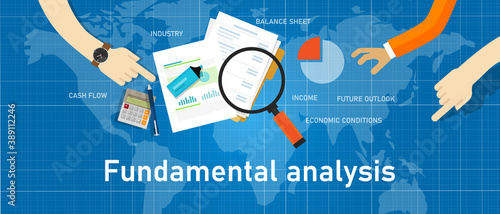By Shravan, Stock Market Enthusiast
In accounting and finance, fundamental analysis is the examination of a company’s financial statements (typically to assess its assets, liabilities, and earnings); health; and rivals, and markets. It also examines aspects like interest rates, production, incomes, employment, GDP, housing, manufacturing, and management, as well as the overall status of the economy.
Fundamental analysis includes:
-Economic analysis
-Industry analysis
-Company analysis
Fundamental analysis is carried out on both historical and current data with the purpose of generating financial forecasts. There are numerous aims that could be pursued:
To determine the intrinsic value of a company’s stock and forecast its likely price evolution; to forecast its business performance; to evaluate its management and make internal business choices and/or to measure its credit risk; to determine the intrinsic value of a company’s stock.”
“Fundamental analysts believe that while markets may price a security erroneously in the short term, the “right” price will eventually be attained. Profits can be generated by purchasing a security that is incorrectly priced and then waiting for the market to correct its “error” and reprice the as-set.”
“A financial statement analysis, which includes financial ratios, is the first step in determining a company’s health. Dividends paid, operating cash flow, fresh equity offerings, and capital financing are all examined. Based on the correctness of the earnings predictions and growth rate projections released extensively by Thomson Reuters and others, they can be classified as “fundamental” (facts) or “technical” (market sentiment).
In various valuation models, determined growth rates (of income and cash) and risk levels (to calculate the discount rate) are employed. The first is the discounted cash flow model, which determines the future present value:
“The P/E ratio is a regularly used simple model” (price-to-earnings ratio). The inverse, or E/P rate, is the discount rate suitable to the risk of the firm, which is implicit in this perpetual annuity (time value of money) model. The disadvantage of using the P/E ratio is that it ignores future earnings growth.
The PEG ratio is more relevant than the P/E ratio since the future growth of a company’s free cash flow and earnings drives its fair value. The PEG ratio takes into account future profits growth pre-dictions, such as EBIT. Its validity is determined by the length of time experts predict growth will continue and the reasonableness of future estimates in comparison to growth (oftentimes the last seven years). Current P/E and historical growth rates for the equities compared to a comparison index can be used to predict changes in growth using IGAR models.
The quantity of debt held by a firm is also a significant factor in evaluating its financial leverage and health. This is significant because raising the amount of net debt allows a corporation to achieve better profitability (and thus a higher return on equity and P/E ratio). The debt-to-equity ratio, current ratio (current assets/current liabilities), and return on capital employed can all be used to swiftly measure this (ROCE). The ROCE is calculated by dividing EBIT by “capital employed,” which is defined as “all current and non-current assets less operational liabilities, which is the company’s real capital, regardless of whether it is financed by equity or debt.”
Picture Credit: Adobe Stock Images

